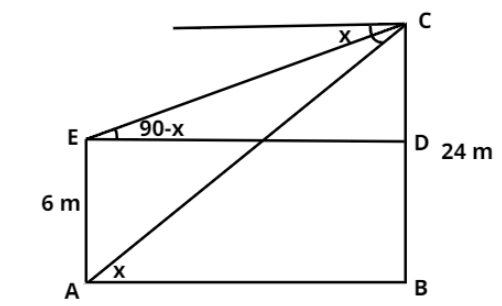
The angle of elevation of the top of a $24{\text{ m}}$ high pillar from the window of a building $6{\text{ m}}$ above the ground and the angle of depression of its base are complementary angles. The distance of building from pillar is:
(A) $2\sqrt 3 {\text{ m}}$
(B) $8\sqrt 3 {\text{ m}}$
(C) $12\sqrt 3 {\text{ m}}$
(D) $6\sqrt 3 {\text{ m}}$
Answer
574.2k+ views
Hint: Analyse the situation with a diagram. Consider two different triangles for angle of elevation and angle of depression and compare the results obtained from both of them. Use formula $\tan \theta = \dfrac{{{\text{Perpendicular}}}}{{{\text{Base}}}}$
Complete step-by-step answer:

Consider the above diagram. AE is representing the building while E is the position of window. BC is a pillar.
According to the question, the angle of elevation from the window and angle of depression of the base of the building are complementary angles i.e. their sum is ${90^ \circ }$. So if $\angle CAB = x$ then $\angle CED = 90 - x$.
Let the length AB, which is the distance of the building from pillar, to be $h$, $AB = h$.
Now, in triangle ABC:
$
\Rightarrow \tan x = \dfrac{{BC}}{{AB}} \\
\Rightarrow \tan x = \dfrac{{24}}{h}{\text{ }}.....{\text{(1)}} \\
$
Again in triangle DCE,
$ \Rightarrow \tan \left( {90 - x} \right) = \dfrac{{CD}}{{DE}}$
From the figure, we have:
$ \Rightarrow DE = AB = h$
$ \Rightarrow CD = CB - DB$ and $DB = EA = 6{\text{ m}}$ whereas $CB = 24{\text{ m}}$.
Thus, $CD = 24 - 6 = 18{\text{ m}}$
Putting these values in above expression, we’ll get:
$ \Rightarrow \tan \left( {90 - x} \right) = \dfrac{{18}}{h}$
We know that $\tan \left( {90 - x} \right) = \cot x$. So we have:
$ \Rightarrow \cot x = \dfrac{{18}}{h}{\text{ }}.....{\text{(2)}}$
Now multiplying equation (1) and (2) we’ll get:
$ \Rightarrow \tan x\cot x = \dfrac{{24}}{h} \times \dfrac{{18}}{h}$
We know that $\tan x\cot x = 1$. Using this, we’ll get:
$
\Rightarrow 1 = \dfrac{{6 \times 4 \times 6 \times 3}}{{{h^2}}} \\
\Rightarrow {h^2} = {6^2} \times {2^2} \times 3 \\
$
Taking square root both sides, we have:
$
\Rightarrow h = 6 \times 2\sqrt 3 \\
\Rightarrow h = 12\sqrt 3 \\
$
Thus the distance of the building from the pillar is \[12\sqrt 3 \].
(C) is the correct option.
Note: The formula of $\tan \theta $ is used in a triangle whenever a relation between two non-hypotenuse sides of the triangle is required. Other trigonometric ratios can also be used if hypotenuse is to be determined or a relation between hypotenuse and any other side is to be compared.
Complete step-by-step answer:

Consider the above diagram. AE is representing the building while E is the position of window. BC is a pillar.
According to the question, the angle of elevation from the window and angle of depression of the base of the building are complementary angles i.e. their sum is ${90^ \circ }$. So if $\angle CAB = x$ then $\angle CED = 90 - x$.
Let the length AB, which is the distance of the building from pillar, to be $h$, $AB = h$.
Now, in triangle ABC:
$
\Rightarrow \tan x = \dfrac{{BC}}{{AB}} \\
\Rightarrow \tan x = \dfrac{{24}}{h}{\text{ }}.....{\text{(1)}} \\
$
Again in triangle DCE,
$ \Rightarrow \tan \left( {90 - x} \right) = \dfrac{{CD}}{{DE}}$
From the figure, we have:
$ \Rightarrow DE = AB = h$
$ \Rightarrow CD = CB - DB$ and $DB = EA = 6{\text{ m}}$ whereas $CB = 24{\text{ m}}$.
Thus, $CD = 24 - 6 = 18{\text{ m}}$
Putting these values in above expression, we’ll get:
$ \Rightarrow \tan \left( {90 - x} \right) = \dfrac{{18}}{h}$
We know that $\tan \left( {90 - x} \right) = \cot x$. So we have:
$ \Rightarrow \cot x = \dfrac{{18}}{h}{\text{ }}.....{\text{(2)}}$
Now multiplying equation (1) and (2) we’ll get:
$ \Rightarrow \tan x\cot x = \dfrac{{24}}{h} \times \dfrac{{18}}{h}$
We know that $\tan x\cot x = 1$. Using this, we’ll get:
$
\Rightarrow 1 = \dfrac{{6 \times 4 \times 6 \times 3}}{{{h^2}}} \\
\Rightarrow {h^2} = {6^2} \times {2^2} \times 3 \\
$
Taking square root both sides, we have:
$
\Rightarrow h = 6 \times 2\sqrt 3 \\
\Rightarrow h = 12\sqrt 3 \\
$
Thus the distance of the building from the pillar is \[12\sqrt 3 \].
(C) is the correct option.
Note: The formula of $\tan \theta $ is used in a triangle whenever a relation between two non-hypotenuse sides of the triangle is required. Other trigonometric ratios can also be used if hypotenuse is to be determined or a relation between hypotenuse and any other side is to be compared.
Recently Updated Pages
Two men on either side of the cliff 90m height observe class 10 maths CBSE

What happens to glucose which enters nephron along class 10 biology CBSE

Cutting of the Chinese melon means A The business and class 10 social science CBSE

Write a dialogue with at least ten utterances between class 10 english CBSE

Show an aquatic food chain using the following organisms class 10 biology CBSE

A circle is inscribed in an equilateral triangle and class 10 maths CBSE

Trending doubts
Why is there a time difference of about 5 hours between class 10 social science CBSE

Write a letter to the principal requesting him to grant class 10 english CBSE

What is the median of the first 10 natural numbers class 10 maths CBSE

The Equation xxx + 2 is Satisfied when x is Equal to Class 10 Maths

Which of the following does not have a fundamental class 10 physics CBSE

State and prove converse of BPT Basic Proportionality class 10 maths CBSE




